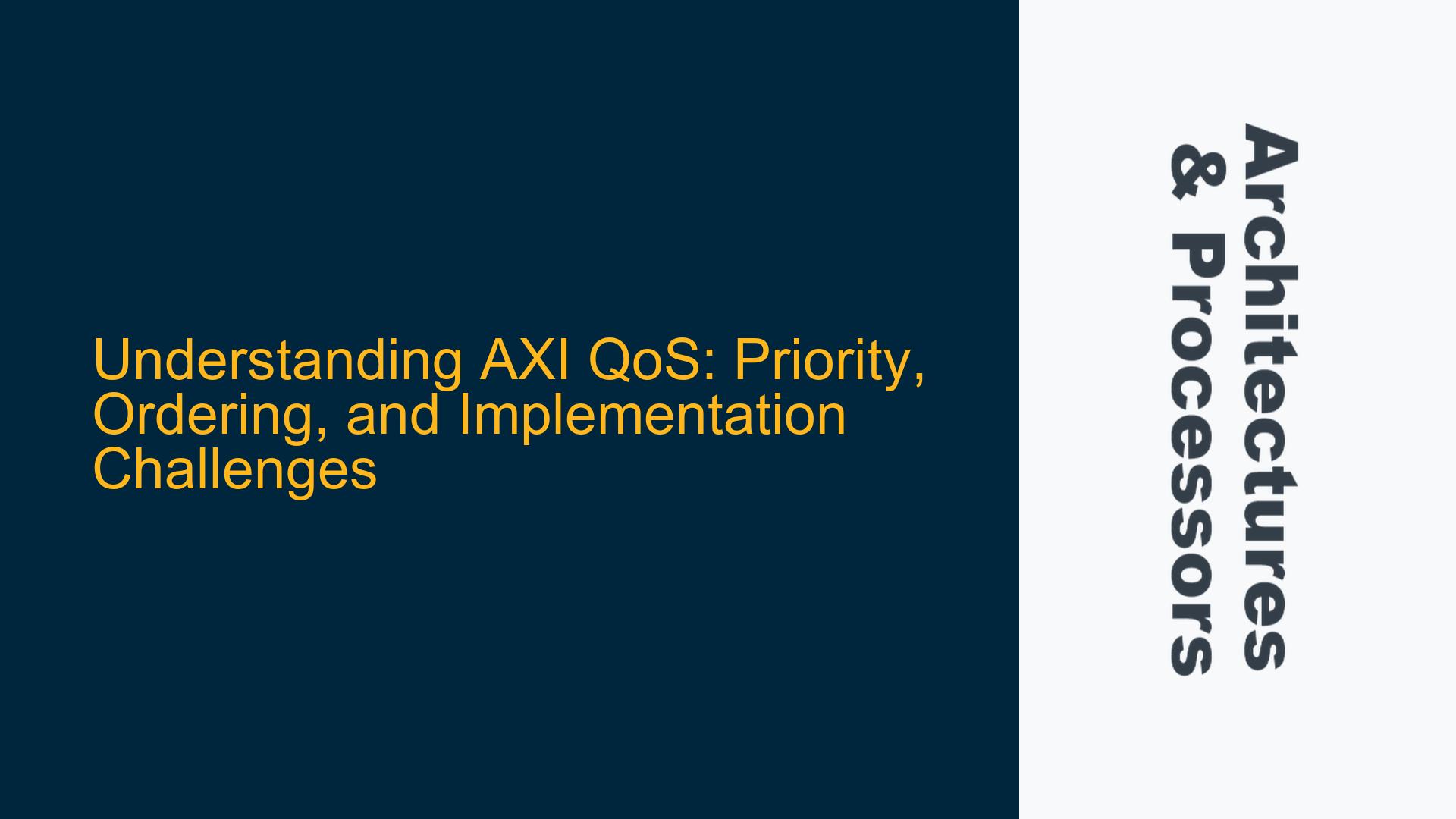AXI QoS Mechanism and Observed In-Order Behavior
The AXI (Advanced eXtensible Interface) protocol incorporates Quality of Service (QoS) signaling to manage transaction priorities and optimize system performance. The QoS values, represented by the AxQoS signals (awqos for write transactions and arqos for read transactions), are intended to influence the priority and ordering of transactions within the AXI fabric. However, in practical implementations, the observed behavior often deviates from expectations, particularly when transactions appear to execute in-order despite varying QoS values.
The AXI specification defines AxQoS as a 4-bit signal, allowing values from 0 to 15, where a higher value indicates a higher priority. The expectation is that transactions with higher QoS values should be prioritized over those with lower values, potentially reordering transactions to improve system efficiency. However, the specification does not mandate specific behavior, leaving implementation details to the discretion of the designer. This flexibility can lead to scenarios where QoS values do not result in the expected reordering, as observed in the provided capture where transactions with varying awqos and arqos values execute sequentially.
The in-order behavior can be attributed to several factors, including the design of the AXI interconnect, the configuration of the master and slave devices, and the specific use case being implemented. For instance, some interconnects may prioritize simplicity and determinism over dynamic reordering, leading to in-order execution regardless of QoS values. Additionally, certain masters or slaves may not fully utilize the QoS signals, treating them as informational rather than directive.
Misalignment Between QoS Values and Transaction Ordering
The core issue lies in the misalignment between the intended use of QoS values and the actual behavior of the AXI fabric. While the AXI specification recommends using AxQoS as a priority indicator, it does not enforce a specific mechanism for handling these priorities. This ambiguity can lead to inconsistent behavior across different implementations.
One possible cause of this misalignment is the lack of standardized handling of QoS values within the AXI interconnect. Different interconnects may interpret and act upon QoS values differently, leading to varying levels of reordering and prioritization. For example, some interconnects may only use QoS values for arbitration between competing transactions, while others may use them for both arbitration and reordering.
Another factor is the configuration of the master and slave devices. Masters may not always generate transactions with appropriate QoS values, or slaves may not respond to these values as expected. This can result in a situation where the interconnect receives transactions with varying QoS values but does not reorder them due to limitations in the master or slave implementations.
Additionally, the specific use case being implemented can influence the observed behavior. In some cases, the nature of the transactions may require in-order execution, overriding any QoS-based reordering. For example, certain memory access patterns or data dependencies may necessitate sequential execution to maintain correctness.
Implementing and Verifying QoS-Based Reordering
To address the challenges associated with QoS-based reordering, a systematic approach to implementation and verification is required. This involves understanding the specific requirements of the system, configuring the AXI interconnect appropriately, and thoroughly verifying the behavior under various conditions.
The first step is to define the desired behavior of the AXI fabric with respect to QoS values. This includes specifying how transactions should be prioritized and reordered based on their QoS values, as well as any constraints or requirements that must be met. This definition should be documented in the design specification and used as a reference throughout the implementation process.
Next, the AXI interconnect must be configured to support the desired QoS behavior. This may involve setting parameters such as arbitration policies, reordering thresholds, and priority levels. The configuration should be validated through simulation to ensure that it meets the specified requirements.
Verification of QoS-based reordering requires a comprehensive test plan that covers a wide range of scenarios. This includes testing with different combinations of QoS values, transaction types, and system configurations. The test plan should also include corner cases, such as transactions with the same QoS value or transactions that require in-order execution.
To facilitate verification, a set of testbenches and monitors should be developed to track the behavior of the AXI fabric and ensure that it aligns with the specified requirements. These testbenches should be capable of injecting transactions with varying QoS values and monitoring the resulting order of execution. Any deviations from the expected behavior should be flagged and investigated.
In addition to simulation-based verification, it may be necessary to perform hardware validation to confirm that the AXI fabric behaves as expected in a real-world environment. This can involve running tests on a prototype or production system and comparing the observed behavior with the simulation results.
By following these steps, designers can ensure that the AXI fabric correctly implements QoS-based reordering and meets the performance and functional requirements of the system. This approach not only addresses the immediate issue of in-order execution but also provides a foundation for future enhancements and optimizations.
Detailed Analysis of AXI QoS Implementation
To further understand the challenges and solutions related to AXI QoS implementation, it is essential to delve into the specifics of how QoS values are handled within the AXI protocol and the potential pitfalls that can arise.
AXI QoS Signaling and Interpretation
The AXI protocol defines QoS signaling through the AxQoS signals, which are part of the address channel for both read and write transactions. These signals are intended to convey the priority of the transaction, with higher values indicating higher priority. However, the interpretation and handling of these signals are left to the discretion of the AXI interconnect and the connected devices.
In practice, the handling of QoS values can vary significantly between different implementations. Some interconnects may use QoS values strictly for arbitration, determining which transaction should be granted access to a shared resource. Others may use QoS values for both arbitration and reordering, allowing higher-priority transactions to bypass lower-priority ones in the transaction queue.
The variability in QoS handling can lead to inconsistencies in behavior, particularly when transactions with different QoS values are issued by multiple masters. For example, if one master issues a series of high-priority transactions while another issues low-priority transactions, the interconnect may prioritize the high-priority transactions but not necessarily reorder them relative to each other.
Impact of Interconnect Design on QoS Behavior
The design of the AXI interconnect plays a crucial role in determining how QoS values are handled. Interconnects can be designed with different levels of sophistication, ranging from simple, fixed-priority arbiters to complex, dynamic reordering engines.
Simple interconnects may use a fixed-priority arbitration scheme, where transactions are granted access to the bus based on a predefined priority order. In such cases, QoS values may be used to determine the priority of each transaction, but the interconnect may not have the capability to reorder transactions beyond the initial arbitration.
More sophisticated interconnects may incorporate dynamic reordering mechanisms, allowing transactions to be reordered based on their QoS values and other factors such as data dependencies and resource availability. These interconnects may also include features such as transaction buffering, speculative execution, and out-of-order completion, which can further complicate the handling of QoS values.
The choice of interconnect design can have a significant impact on the observed behavior of QoS-based reordering. Simple interconnects may result in more predictable, in-order execution, while complex interconnects may introduce variability and non-determinism.
Master and Slave Device Behavior
The behavior of the master and slave devices connected to the AXI fabric also influences the handling of QoS values. Masters are responsible for generating transactions with appropriate QoS values, while slaves are responsible for responding to these values in a manner consistent with the system requirements.
Masters may vary in their ability to generate transactions with meaningful QoS values. Some masters may have sophisticated QoS generation logic, allowing them to dynamically adjust QoS values based on system conditions. Others may use fixed QoS values or generate transactions without considering QoS at all.
Slaves, on the other hand, may vary in their ability to respond to QoS values. Some slaves may prioritize transactions based on QoS values, while others may ignore them entirely. The behavior of the slaves can significantly impact the overall system performance, particularly in systems with multiple masters and slaves.
System-Level Considerations
At the system level, the handling of QoS values must be considered in the context of the overall system architecture and performance requirements. Different systems may have different priorities and constraints, which can influence the design and implementation of the AXI fabric.
For example, a system with real-time requirements may prioritize low-latency, high-priority transactions, while a system with high-throughput requirements may prioritize efficient use of bandwidth. The choice of QoS handling mechanisms must align with these priorities to ensure that the system meets its performance goals.
Additionally, the system-level design must consider the impact of QoS handling on other aspects of the system, such as power management, thermal management, and fault tolerance. For example, prioritizing high-priority transactions may increase power consumption or generate additional heat, which must be managed to avoid system failures.
Verification Strategies for QoS-Based Reordering
Verifying the correct implementation of QoS-based reordering requires a comprehensive and systematic approach. This involves developing a detailed test plan, creating appropriate testbenches and monitors, and executing a series of tests to validate the behavior of the AXI fabric.
The test plan should cover a wide range of scenarios, including different combinations of QoS values, transaction types, and system configurations. It should also include corner cases, such as transactions with the same QoS value or transactions that require in-order execution.
Testbenches should be designed to inject transactions with varying QoS values and monitor the resulting order of execution. These testbenches should be capable of simulating different system conditions, such as varying levels of contention for shared resources, to ensure that the AXI fabric behaves correctly under all conditions.
Monitors should be used to track the behavior of the AXI fabric and compare it with the expected behavior based on the design specification. Any deviations from the expected behavior should be flagged and investigated to identify the root cause of the issue.
In addition to simulation-based verification, hardware validation may be necessary to confirm that the AXI fabric behaves as expected in a real-world environment. This can involve running tests on a prototype or production system and comparing the observed behavior with the simulation results.
Conclusion
The implementation and verification of QoS-based reordering in AXI-based systems present several challenges, including variability in QoS handling, the impact of interconnect design, and the behavior of master and slave devices. Addressing these challenges requires a systematic approach that includes defining the desired behavior, configuring the AXI interconnect appropriately, and thoroughly verifying the behavior under various conditions.
By following this approach, designers can ensure that the AXI fabric correctly implements QoS-based reordering and meets the performance and functional requirements of the system. This not only addresses the immediate issue of in-order execution but also provides a foundation for future enhancements and optimizations.






